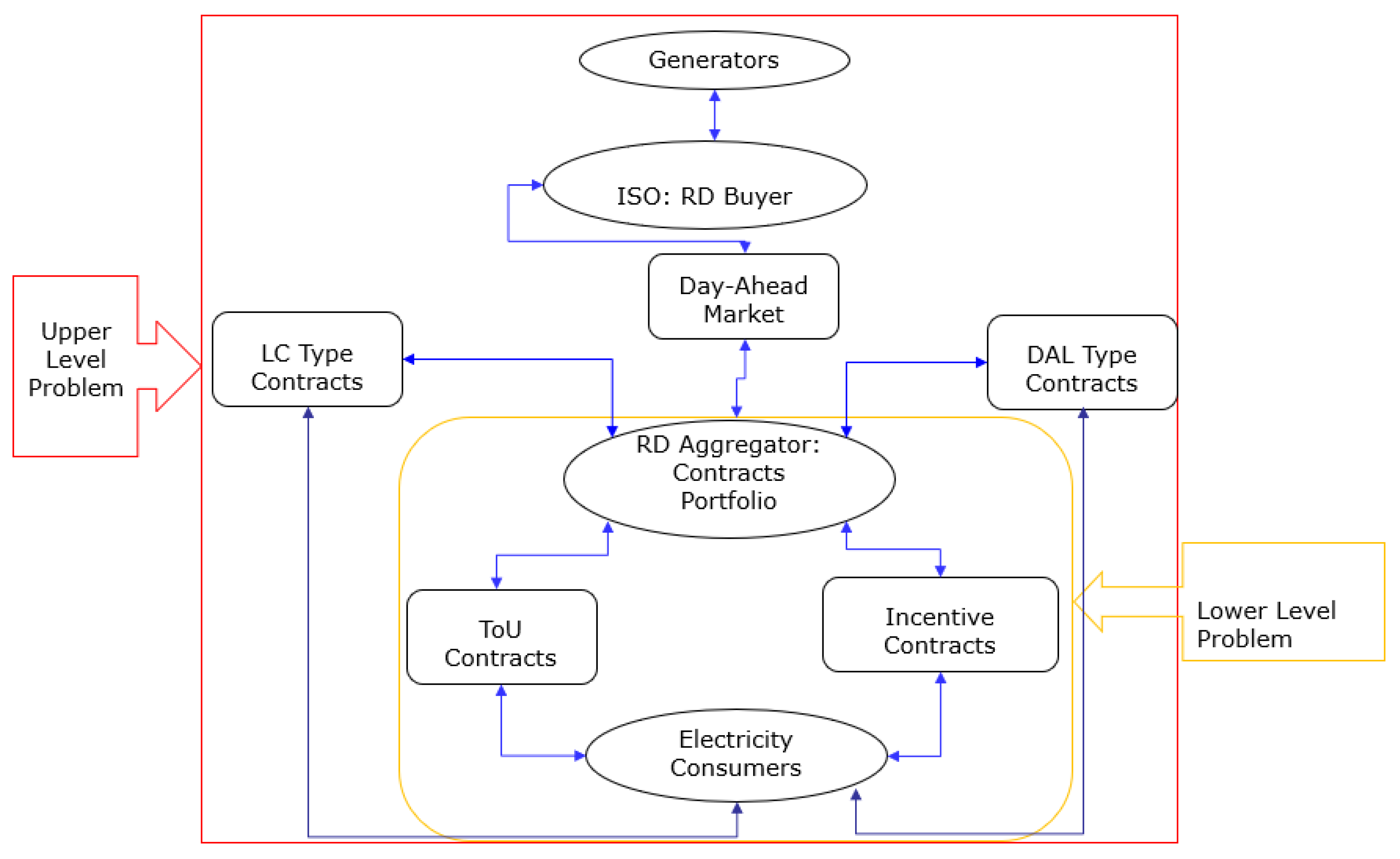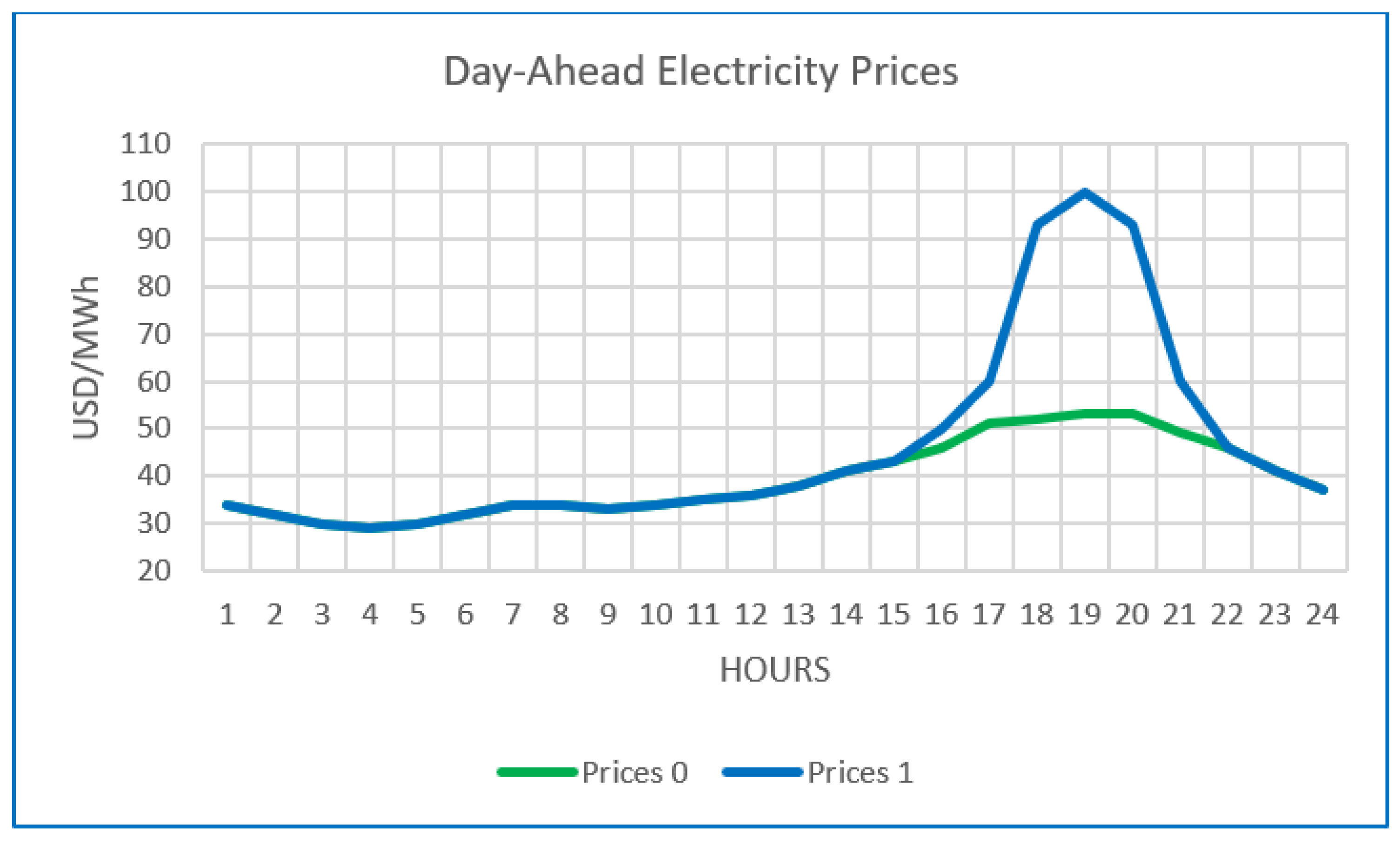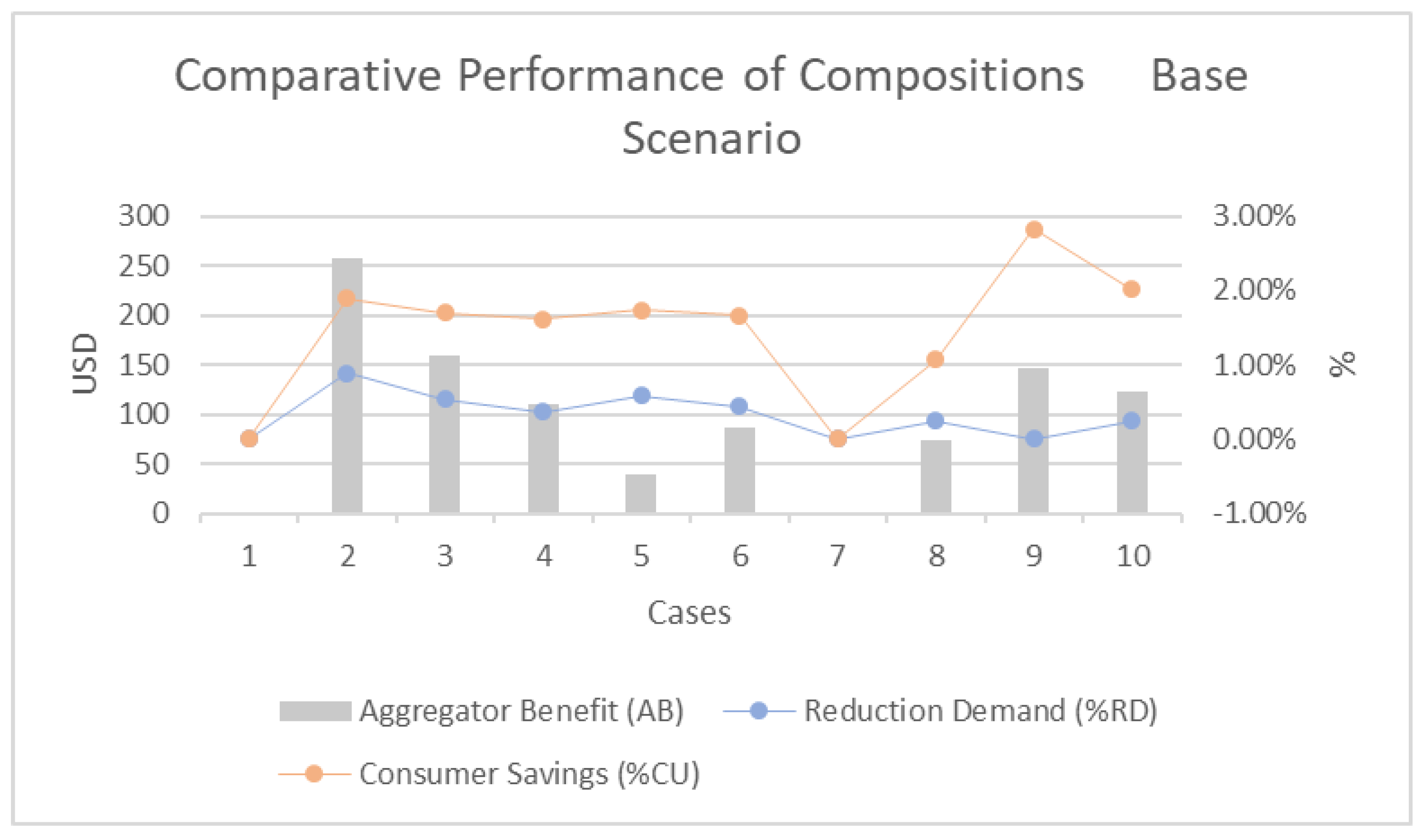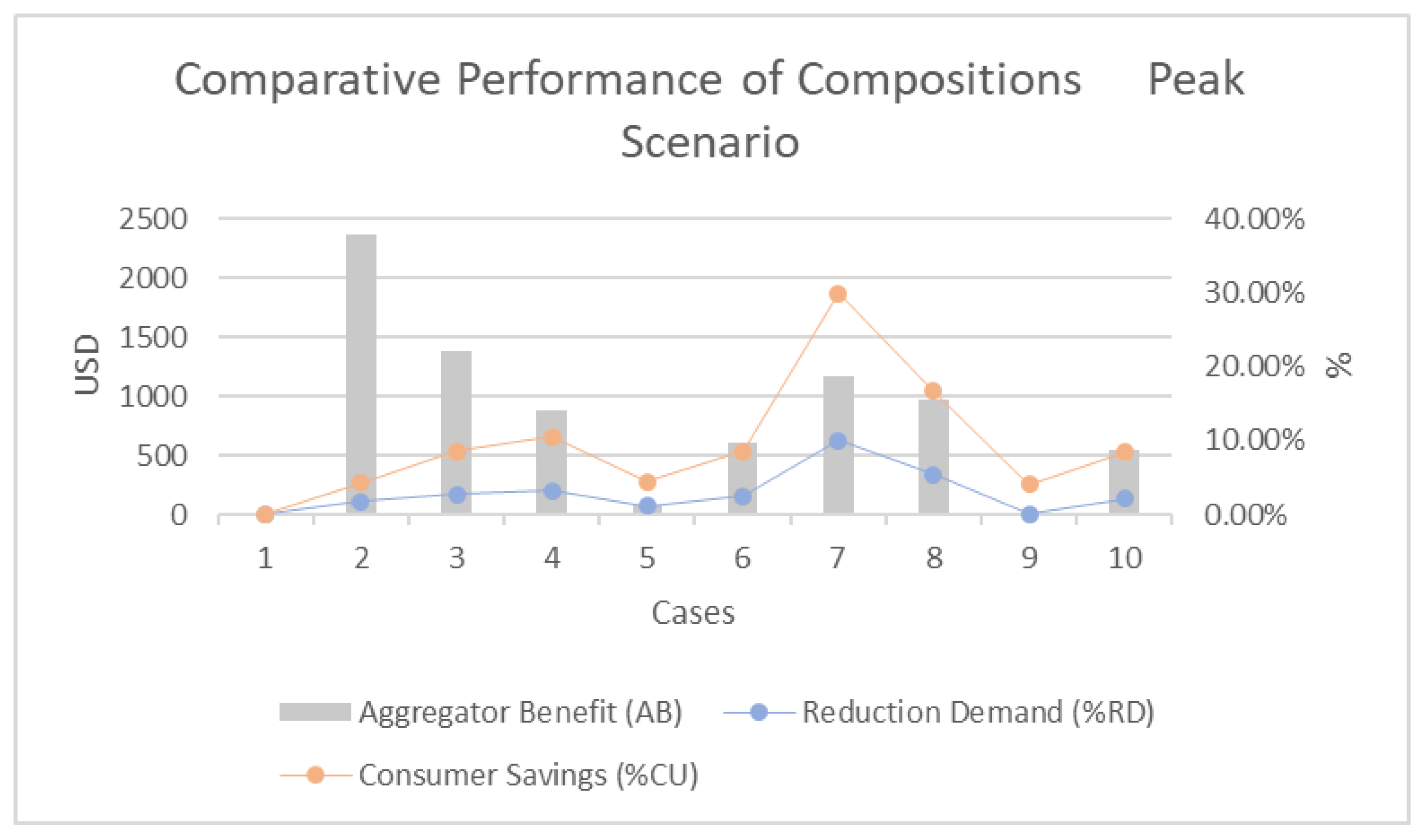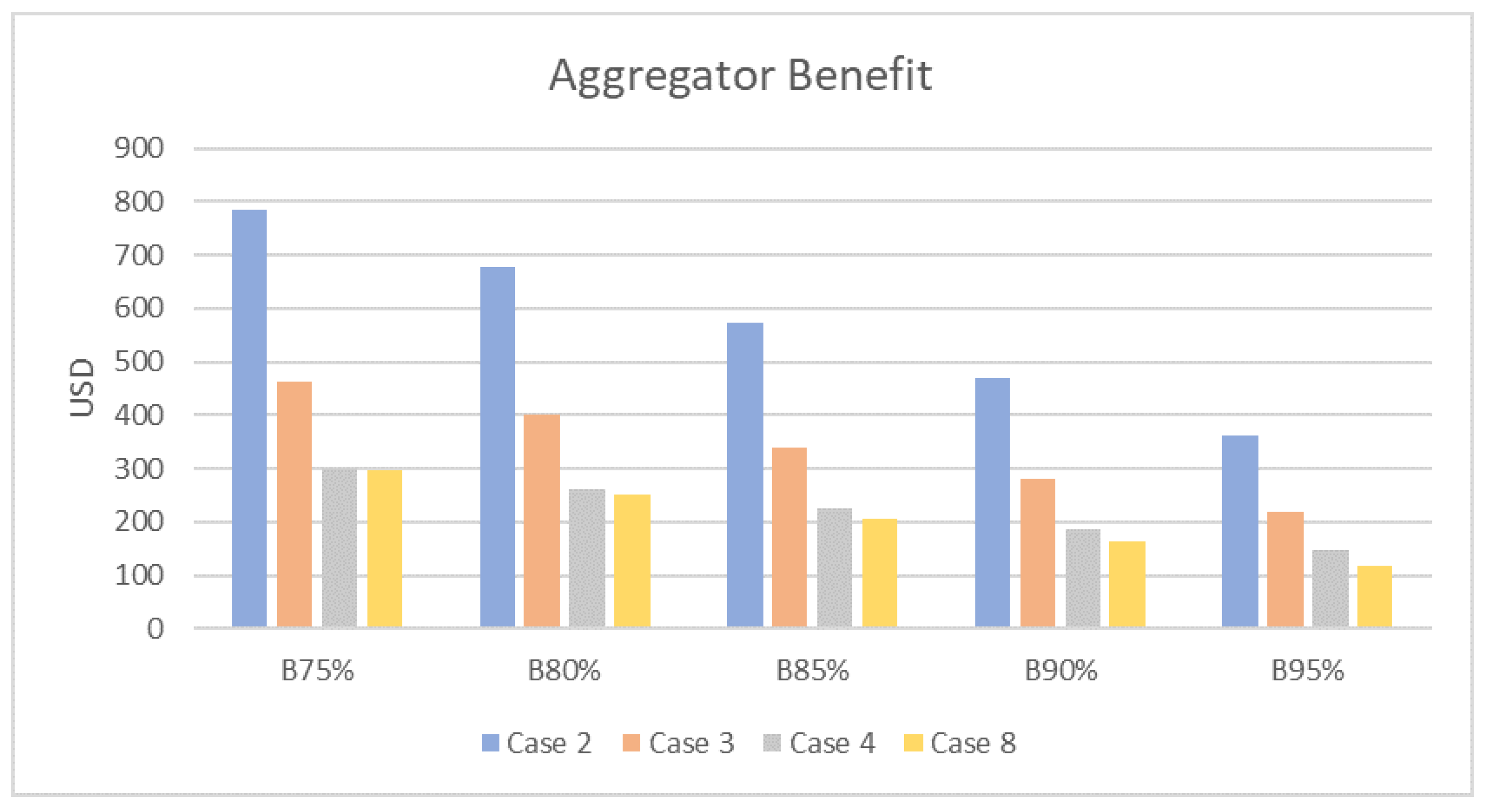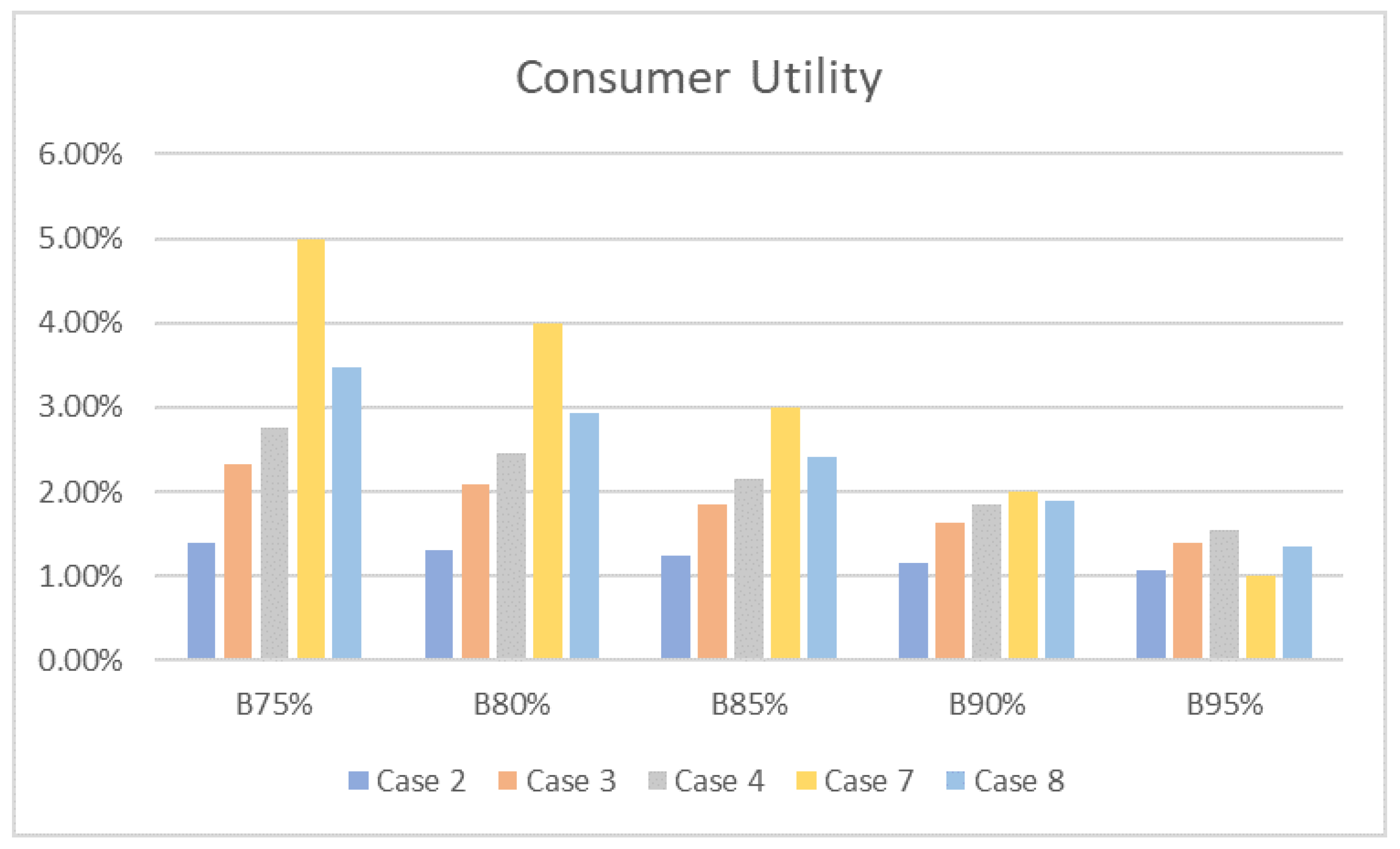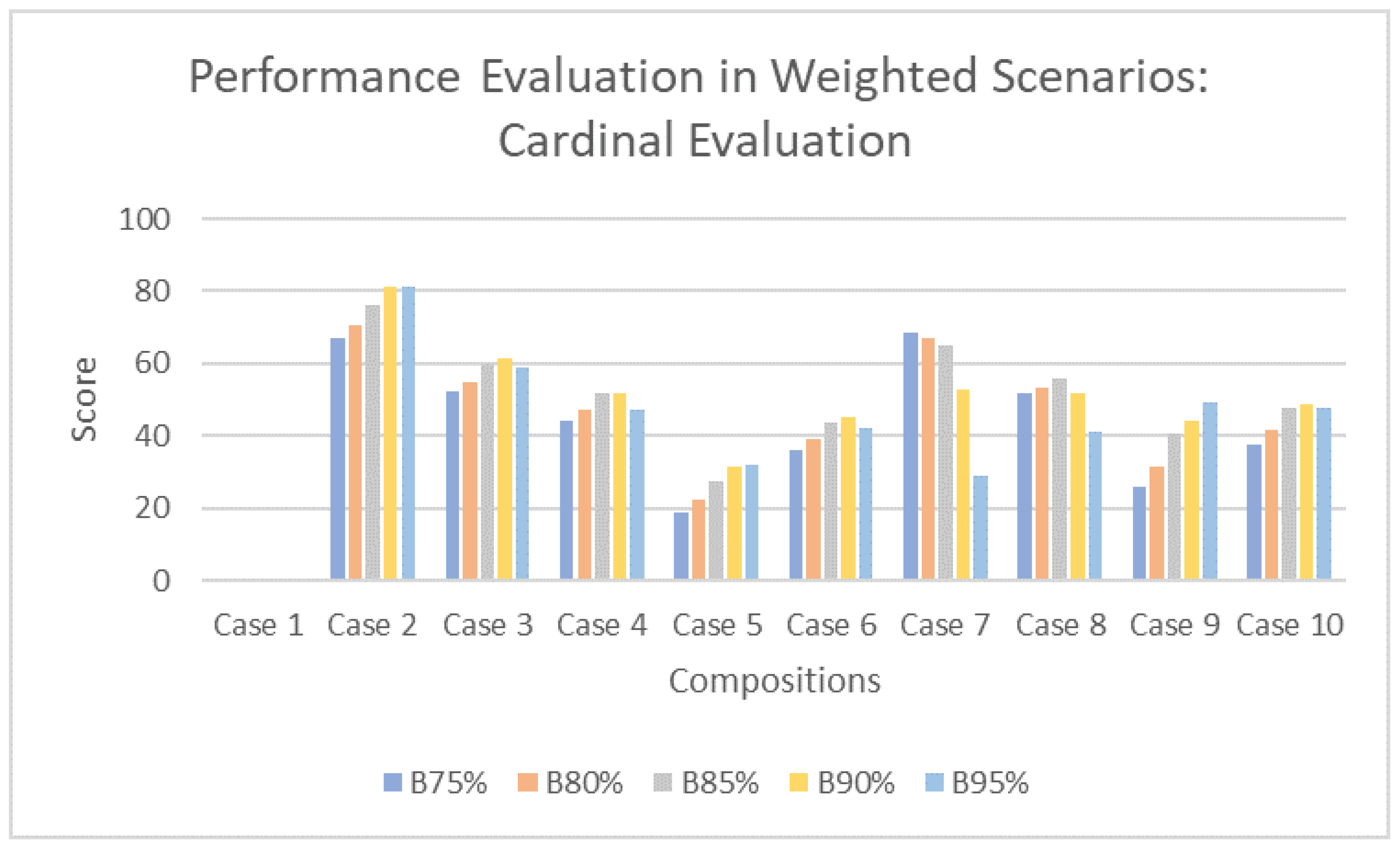1. Introduction
The energy sector, in particular, electricity, is evolving towards a more sustainable model, supported by renewable sources, storage systems and active demand, in a distributed configuration. To properly operate this complex and uncertain system, adequate energy management techniques are required. One of the main challenges in the modernization of power grids is the involvement of consumers as active components of energy systems, in what is called demand response or demand side management.
Demand response (DR) has been defined as “The change in electricity use by final consumers from normal consumption patterns in response to changes in the price of electricity over time, or to incentive payments designed to induce a reduction in electricity use in scenarios of high wholesale market prices or when system reliability is at risk” [
1]. This definition, given by the US Department of Energy, has been broadly adopted by academia in the research on DR [
2].
The coordinated participation of DR allows for the improvement of the economic efficiency in electricity markets since DR can reduce peak demand and price volatility [
3]. Additionally, in a scenario with a high penetration of stochastic renewable sources, DR promises to be a better alternative than using polluting and costly reserves to balance the variability of renewable generation [
4]. Countries such as the United States have prescribed that DR resource owners can offer this service as a resource supply for greater market transparency [
5]. Therefore, shaping the demand to reduce the peak and smooth power variations allows one to improve the efficiency in the operation of the power system, generating large savings [
2,
6].
There is a general consensus regarding the favorable impact of DR on ensuring efficiency and greater flexibility in the operation of the electric system [
7]. The challenge is to design appropriate mechanisms to put this concept into practice so that the full potential of DR is effectively exploited [
8]. Any contract or operational model for an aggregation of DR resources must point to two main objectives: to significantly impact the demand curve as a result of the market price scenario and to guarantee sustainability as a business for the aggregator, so that there is an incentive to address this coordination effort.
DR and its participation in the electricity market have been the subject of extensive research, especially in the last decade, driven by the penetration of stochastic generation technologies [
9]. In addition, the authors of [
10] present a ranking of different alternatives for the feasibility of demand side management services, while detailed summaries of the state of the art in DR models can be found in [
9,
11].
When consumers participate in DR, in general terms there are two possible approaches in which they can change electricity usage: by reducing their energy consumption through strategic load reduction or by shifting energy consumption to a different time or period [
2], unless they generate their own, which leads to a third option.
The fundamentals and business mechanisms of demand response aggregators are presented in [
12], including not only the coordination of consumers, but also of distributed energy resources and storage technologies. Based on information gathered worldwide, the authors highlight the importance of future research focusing on consumer behavior and analyzing the actual contribution of the multiple demand response programs implemented.
There is an important body of research regarding the design of DR contracts and management models by an aggregator. The authors of [
13] consider the types of contracts between consumers and the aggregator, and the management strategies with consumers and the wholesale market, with emphasis on modeling alternatives for each of them, and their corresponding concatenations. Bekiroglu et al. [
14] propose a DR contract for HVAC systems introducing a real-time market and the preferences of the consumers. Vuelvas et al. [
15] proposed a contract for incentive-based demand response that guarantees voluntary participation and asymptotic truthfulness, where consumers must provide their baseline consumption. Muthirayan et al. [
16] presented a mechanism in which participants must report their baseline consumption and marginal utility to the aggregator and, through a probabilistic scheme, the consumers who will provide the DR service are selected. In [
3], a model is presented for a DR aggregator that aims to optimize the execution of DR contracts to participate in the wholesale Day-Ahead (DA) market; however, the composition of its portfolio is predetermined by groups of consumers previously assigned to each type of contract. A DR scheme using bilateral contracts and participation in the DA and Real-Time (RT) markets is presented in [
17]; nevertheless, it assumes the joint engagement of a wind power generator and the aggregator. Henriquez et al. [
18] present an optimization model for the management of a DR aggregator in two instances of the wholesale market, including its strategic participation in the RT market. None of the referenced publications formulates the decision-making problem faced by the consumer in response to the economic signals sent by the aggregator.
Concerning consumer behavior in response to price signals or incentives generated within a DR program, there are several approaches that have been analyzed in the literature. In [
10], the economic model of consumer response is presented, through the maximization of consumer benefit, introducing the concept of own-price and cross-price elasticity. This approach includes the social weighting of the preference for the incentive with respect to price change. In [
11], the proposed model maximizes the consumer’s utility subject to either a daily budget or predefined daily consumption. In [
19], the consumer model is proposed based on Simon’s satisfaction theory [
20], where the incentive should be greater than or equal to the level of aspiration of each consumer. Finally, in [
21], a methodology is proposed for the representation by parameters of different groups of consumers according to their flexibility to respond with shifting consumption or reduction, based on incentives, including behavioral aspects and cultural characteristics that may influence this decision making. The methodologies for the specific characterization of consumer response is not part of the scope of our work, but its consideration is important for the application of the comparison methodology in a particular case.
A successful DR program must take into account the valuable information collected in recent years in a way that considers and harnesses the potentialities of consumers’ ability and willingness to participate in such endeavors. In [
22], a novel methodology is proposed to obtain valuable information from the growing volume of data on electricity consumption that have been and continue to be collected through questionnaires and smart meters. Only on the basis of properly selected and analyzed information will it be possible to establish the tariffs and incentives that truly maximize the success of demand response programs.
From the analysis of the state of the art of DR management models, it can be observed that an aggregator has different alternatives to engage users in demand side management programs. Each contract has its own advantages and limitations. An aggregator that aims to participate in several markets, offering a set of services to the system operator, cannot rely on a single type of DR contract. It must be able to manage a diverse portfolio of contracts, also considering the expected consumer behavior for each scenario.
To assist in the obtention of as much information on the key elements of the management model to be developed as possible, it is important to characterize the types of contracts available to the aggregator to assemble a portfolio of flexible resources.
This research aims to respond to the objective stated in the previous paragraph, evaluating a set of scenarios of operation conditions and prices and considering different configurations of percentage distribution of types of contracts within the portfolio of an aggregator. A methodology is developed to form an optimal portfolio for an aggregator through a bi-level model for the management of a set of dissimilar DR resources. This market agent interacts in two different phases: the first one is an interaction with the wholesale electricity market, participating as a price taker in the DA market, and the second with consumers, by means of a portfolio of different contracts, on which it relies to perform its operational and economic management. The framework considers direct and indirect load control contracts that are acceptable to consumers when compared to the original baseline situation, paying for their consumption through the recognition of an average tariff. Furthermore, the model includes the behavior of consumers based on their preferences, which allows = a response with a high probability of occurrence to be established.
The contributions are summarized as follows:
The main contribution of our work is to describe and illustrate a methodology that allows comparisons of different combinations of demand response contract types, including electricity consumption remuneration conditions, such as flat rate and dynamic tariffs, as well as incentive conditions for consumers.
We use a model that links the aggregator’s upstream and downstream management in such a way that it allows the analysis of the economic feasibility of the business model and the alternatives it can consider, based on the characteristics of the contracts included in its portfolio.
A fundamental aspect of this methodology is the involvement of consumer preferences through the concepts of own- and cross-price elasticity, which allows a response with a high probability of occurrence to be established, discarding the possibility of gaming behavior, which is present when using short-term statistical methods to establish a baseline on which to quantify the effective reduction in consumption.
The proposed methodology allows for the evaluation of the performance of a portfolio with the same types of contracts but with different percentage distributions among them. This analysis is performed in normal situations and in peak price events.
Through a literature search on demand response programs and aggregator management schemes, we did not find analyses that make direct comparisons between different compositions of the same types of contracts, especially considering the aggregator’s benefit criterion. This gap analysis from the aggregator’s perspective is addressed in our research.
The remainder of this paper is organized as follows:
Section 2 presents a theoretical description of the proposed methodology.
Section 3 explains the formulation of the DR aggregator’s optimal management model. Subsequently, in
Section 4, the simulation scenarios are presented and their results are illustrated in detail. Finally,
Section 5 presents the conclusions and future works.
2. Electricity Demand Response Contracts and Optimal Portfolio Methodology
This section describes the main elements that allow the implementation of the methodology through which the aggregator can determine the optimal percentage composition of a portfolio of demand response contracts, consisting of four types of contracts typically used in DR programs implemented in recent years.
2.1. The Demand Response Aggregator
DR can be activated to its full potential through an intermediary agent called an aggregator, which focuses its efforts on recruiting smaller consumers to form an influential group in the market [
3]. Currently, there are operational DR programs involving large industrial consumers and one of the challenges is to extend DR to commercial and residential users, given the untapped potential of participants in DR programs [
1,
23].
Commercial and residential consumers are inexperienced in the electricity business and large in number. For this reason, the presence of a dynamizing agent is required to expose the set of represented consumers to the wholesale market, actively participating with coordinated responses to market behavior signals [
1].
One means of coordinating demand in terms of its participation in the market is by designing a management model that maximizes the profit of a DR aggregator [
1]. Profit maximization is the motivation for this independent agent to structure the dynamic link between demand and the market. To achieve this purpose, it is necessary to count on the voluntary participation of consumers. Therefore, the aggregator’s strategy should consider the structuring of contracts so that consumers profit through their participation in DR. This model should consider the management of the aggregator before the Wholesale Market or System Operator and its consumers. This intermediation function obliges the aggregator’s management before the consumers, both in the subscription of DR contracts and in the coverage of their energy needs [
18].
The wholesale electricity market allows the purchase and sale of this commodity. The DA market takes place the day before the delivery of energy, typically until midnight before, on an hourly basis. Producers send to this market their production bids (consisting of production quantities and minimum selling prices), while consumers and traders send their consumption requests, consisting of hourly consumption quantities and their maximum purchase prices. In turn, the System Operator activates a market balancing tool that generally corresponds to a uniform auction. This mechanism results in the definition of the production levels for each selected agent and the DA balancing price [
24].
2.2. Direct Control Contracts
In general terms, there are two types of DR activation models: Direct Control and Indirect Control. In the case of Direct Control model, the aggregator directly schedules the demand profile by remotely disconnecting equipment of the consumers, who are notified at short notice [
23]. On the other hand, in the case of Indirect Control model, DR is performed by changing the price of energy or giving an incentive payment to participating consumers [
15].
In the case of direct control contracts, participating customers receive compensation for their participation, usually in the form of a bill credit or by applying a payment discount for their participation in the programs. In another alternative scheme, participants are rewarded with money for their performance based on the amount of load reduction during critical conditions.
In direct load control programs, utilities, or the aggregator, in this case, have the ability to remotely shut down participants’ equipment by notifying them shortly before the event. These types of programs may be of interest primarily to residential customers and to small commercial customers to some extent.
Accordingly, a usable scheme corresponds to one in which users are paid for reducing their load to predefined values. Non-responsive participants may face penalties depending on the terms of the scheme. This type of contract is called Load Curtailment (LC) [
18].
On the other hand, another type of direct control contract corresponds to the Deferrable Activation Load (DAL). Loads of consumers participating in DAL contracts can be partially rescheduled during a predefined time window and shifted to off-peak hours at the convenience of the aggregator. Due to this flexibility, consumers are compensated at the lowest hourly rate throughout the day for each MWh defined as deferrable; and their remaining consumption is paid at the average daily rate.
2.3. Indirect Control Contracts
The Indirect Control method is performed by changing the price of energy or giving an incentive payment to participating consumers [
15]. Thus, Indirect Control programs can be classified into two basic categories: price-based DR and incentive-based DR.
Consumers are the basis in these types of DR programs since the success of these undertakings depends on their behavior in response to market signals. Therefore, users must be included in the management model by considering the decisions they make on the basis of both incentive payments and price changes. This leads users to modify their consumption pattern given their preferences in the exchange between two goods: electricity at peak and off-peak hours.
Regarding the modeling of consumers’ behavior, the academic literature considers various concepts, such as the response according to their price elasticity [
10], the level of aspiration, or considering the fulfillment of predefined budget according to their indifference curves [
11]. In this research, consumers’ behavior is modeled considering their characterization through the knowledge of their reaction to price variations or economic incentives to reduce their consumption, through the use of the aggregate price-elasticity matrix.
It is important to mention that the estimation of the parameters associated with the consumer is not part of the scope of this work and is left as a concern for future exploration. On the other hand, this model includes the psychological preference of the society under analysis, with respect to a punishment scheme (response to price variation) over a reward scheme (response to incentive).
In the indirect control programs, the decisions taken by the consumers correspond to the solutions of the problem of maximizing their utility by modifying their electricity demand in response to a price variation signal or an incentive in exchange for its reduction.
2.4. Optimal Portfolio Methodology
This research work addresses the situation in which a DR aggregator participates in the wholesale market and provides energy to its customers through a portfolio of bilateral contracts. At the upper level, the aggregator interacts with the Independent System Operator (ISO), through its participation in the DA market, while at the lower level the aggregator makes the dispatch of consumers’ loads, according to the preset bilateral contracts.
The participation of the DR aggregator in an open electricity market occurs in the DA instance, where it acts as a price taker, given the size of this market. In addition, it is assumed that the aggregator has an accurate forecast of the resulting price scenario it faces, based on historical market information. The authors of [
25] present a comparison of the traditional algorithms used to forecast the price of electricity in the wholesale market, providing a recommendation of the approach that produces the most accurate results. This analysis is not part of our scope but is necessary for the implementation of the proposed contract composition comparison methodology.
In addition to considering the interaction of the DR aggregator upstream with the DA market, it is also necessary to take into account its downstream management through the different contracts with consumers. In this interaction, the aggregator sends economic signals of price variation or incentive that the consumers receive to solve their utility maximization problem as a function of their demand response.
The problem to be solved throughout this analysis corresponds to the definition of a methodology that allows the aggregator to establish which combination of DR contracts yields the best results concerning three evaluation criteria: greater benefit to the aggregator, greater utility for consumers, and greater reduction in electricity consumption. This methodology is illustrated through the analysis of specific cases.
This optimization problem is integrated by a higher level problem, whose objective function to maximize corresponds to the aggregator’s profit from its interaction with the electricity market and the response it receives from the consumers recruited through the bilateral contracts subscribed. Additionally, within the constraints of the optimization problem, the solution of two lower-level problems must be considered: the maximization of the utility that each consumer performs based on the electricity prices or the incentives offered, according to the type of contract subscribed and under the assumption of economic rationality behavior.
Figure 1 illustrates the concatenation of these optimization problems, which correspond to the integral model that is designed.
Among the assumptions, it is important to highlight the adopted hypothesis of consumer economic rationality, which is the basis of the solution to the problem of demand response to price or incentive signals. With respect to the maximum demand considered as shiftable or reduced by consumers, we include the assumption, based on the literature, that its value can be considered as approximately 10% of the original hourly demand. Similarly, the values of consumer price elasticities are taken from those typically reported for some social groups where particular econometric analyses were performed for their definition. The methodology to conduct these econometric studies and, in general, behavioral economics and consumer demand response potential analysis is not part of the scope of our research.
4. Simulations and Results
4.1. Definition of Portfolio and Price Scenarios
This subsection presents the scenarios considered in the simulations with the implemented model. The scenarios and simulated cases are defined to show the impacts that the coordinated DR has on the aggregator’s profit and on the cost to be covered by the different types of consumers. Consumers are classified according to the contract subscribed, through a portfolio that includes the types of contract defined here. This analysis includes the effects of varying the participation of these contracts on the same aggregate demand.
4.1.1. Price Scenarios
Two scenarios of hourly electricity prices in the DA market are selected for the analyses (see
Figure 2), namely:
Base Case (Prices 0): Corresponds to a typical electricity price curve of a usual day, where there is no peak price event. The information used represents a scenario of usual prices of the CAISO (California Independent System Operator) system, specifically for July 2015 [
31].
Case High Prices in Peak Hours (Prices 1): This price curve presents hourly values similar to the usual ones in off-peak hours, but its prices increase significantly in peak hours. This scenario corresponds to those days when, for example, a system with an energy matrix highly dependent on hydrology goes through a strong drought and high decrease in the levels of reservoirs. In this type of event, demand during peak price hours is usually met by dispatching generation sources dependent on high-cost liquid fuels.
Figure 2 shows the curves that describe the price scenarios considered in the simulations.
4.1.2. Portfolio Scenarios
In the definition of these scenarios, the composition of the portfolio corresponds to the percentage allocation of four types of contracts, two of direct control and two of indirect control: Load Reduction Contracts (LC), Deferrable Load Activation Contracts (DAL), Reduction by Incentive Contracts (RI) and Price Variation Contracts (ToU), respectively.
In order to quantify the effects of the implementation of the DR program, the aggregate demand, prior to the implementation of the program, of the consumers coordinated by the aggregator is established as a baseline. For each hour of the day there is a defined amount of energy, assuming perfect homogeneity in the demand of each user. In this baseline, all consumers are subject to a single tariff for each kWh consumed in any of the 24 h; this tariff corresponds to the weighted average tariff of a usual day. A usual day is understood as one in which there is no punctual or sustained peak price event, concerning short-term historical information.
To capture the effect of the difference in the composition of the contract portfolio, discrete cases are analyzed, starting with an equal participation of each of the contract types; that is, each 25% of consumers participate with a different type of contract, among the four defined types. Subsequently, this composition is modified by varying the participation of each contract from 0% to 100%, while the remaining percentage of the demand is served by the other three contracts.
It is important to highlight the restriction that the maximum demand susceptible to being reduced or displaced by each type of contract is 10% of the total demand served by that type of contract for each of the hours of the day [
27].
Figure 3 illustrates the total hourly demand of the users recruited by the aggregator for an average day. It is the baseline when no DR program is implemented. This curve has been assembled based on typical load profiles in the CAISO market.
4.1.3. Particular Characteristics of the Portfolio Contracts
The characteristics adopted in each type of contract are as follows:
Contract-tsype LC (LC): Consumers recruited with this type of contract receive the electric energy service in a manner that covers their demand in exchange for the payment of the average daily tariff per MWh consumed. In the events in which the aggregator activates the DR of any of the contracts of this type, consumers reduce their consumption by the amount requested by the aggregator. Each contract predefines the range of reduction that may be demanded by the aggregator and the maximum daily number of times it may be activated. In compensation, each user receives payment of a value equivalent to the average tariff for each MWh not consumed, an amount assumed as representative of the price at which the users value the energy in their utility function. In the detailed structuring of this type of contract, the value of the penalty for non-compliance with this commitment should be considered, using analyses addressed by [
4], not included in the comparative analysis approached in this paper.
DAL-type contracts (DAL): In these contracts, a maximum percentage of 10% of the loads of consumers participating in these contracts can be rescheduled during a predefined time window and shifted to off-peak hours at the convenience of the aggregator. Due to this flexibility, consumers are compensated with the lowest hourly rate charge throughout the day for each MWh defined as deferrable activation; their remaining consumption is paid at the average tariff.
Reduction by incentive contracts (RI): In this type of contract, the aggregator within its model decides in which hour to generate an incentive and the value of the incentive according to the amount of demand reduction required. This value of the incentive is determined according to the consumer’s self-price elasticity, previously established, through historical analysis of the consumer’s behavior before this input and incorporated in the contract explicitly. This characterization is not developed in this research work. The consumers, in turn, receive notice of the time and value of the incentive, as well as the target load reduction. The rest of their demand is paid through the value of the average tariff.
ToU contracts (ToU): The aggregator defines three tariff levels of homogeneous duration (8 h), such that their weighted average, in base conditions, is equivalent to the average daily tariff. In this type of contract the consumers vary their consumption pattern according to their willingness. The behavior of the consumers is predicted by the aggregator, according to the self and crossed price elasticity of the users. The consumers pay for their consumption according to the tariff in force at the time of consumption.
4.2. Base Scenario or Price 0
Table 1 shows the results of the 10 cases of variation in the composition of this portfolio for the “price 0” or base case. This case corresponds to a typical day where no major peak event is generated, including that scenario where no demand response program has been implemented.The columns RI, TOU, LC and DAL present the share of each type of contract for each case, RD—demand reduction, CU—consumer utility and AB—aggregator benefit.
The comparison between the behavior of the cases is illustrated in
Figure 4 and their analysis for each of the three comparison criteria used is presented in the following subsections.
4.2.1. Lower Consumer Payments
The portfolio that offers the greatest benefit to consumers is the one in which the entire portfolio corresponds to 100% of the deferred activation load contracts (DAL-type contract). This criterion is quantified as the amount that those involved save by interacting with the market and responding to the corresponding price signals. This type of demand response means, in the simulated cases, that the involved participants pay 97% of the value corresponding to the case when no DR program is present. It is worth noting that in this case demand does not suffer a net reduction.
In the base case, market prices present a deviation of ±30% concerning the average tariff, in addition to the fact that there is a correlation between typical demand and prices behavior. Therefore, there is insufficient motivation for users to significantly modify their consumption or for the aggregator to generate incentives that lead to behavioral responses. This analysis is supported by the fact that the greatest impact on consumption bills is found in contracts where up to 10% of the demand is transferred to the hour with the lowest consumption price, which is approximately 30% lower than the average daily rate.
For this variable, the next best performing compositions correspond to those where the share of DAL contracts is reduced to 50% and 25% of demand, respectively, with the rest of the demand distributed homogeneously among the other three types of contracts.
The importance of DAL-type contracts concerning the lowest price to be paid for electricity consumption is followed by the scenarios in which there is a greater participation of ToU- and RI-type contracts. The order of these two compositions is permuted if inflexible users of ToU contracts are considered.
Special interest in this simulation corresponds to the LC-type contracts, which are not activated in any of the scenarios of the base case. This behavior is explained by the fact that market prices do not offer the necessary incentive for the aggregator to dispatch this type of contract, since in none of the hours the market price is at least the double of the average tariff.
4.2.2. Higher Aggregator Profit
When analyzing the behavior of the composition of the contract portfolio for the aggregator’s profit, the case with the highest value in this variable is the one in which the RI contract corresponds to 100% of the contracts. This case is followed by the composition in which these contracts meet 50% of the demand.
This result indicates that the aggregator’s management model effectively seeks to maximize its profit by using the additional tools that this type of contract provides. This type of contract is the only one in which it has an active role in generating incentives in response to market signals and knowledge of the consumers’ elasticity.
In this case it is worth noting that after these two compositions, the best results are obtained in the cases of high participation of DAL-type contracts. These cases generate benefits to the aggregator, due to the location in the baseline of the demand classified as flexible, at times when the market price is above the average tariff. The displacement of this demand to the lowest cost hour does not totally eliminate the savings generated by its non-dispatch at those initially foreseen hours.
4.2.3. Greater Consumption Reduction
Another very important criterion in the evaluation of the performance of each composition of the aggregator’s portfolio is the net reduction in consumption in the base scenario. With respect to this variable, the composition that yields the greatest reduction is the implementation of RI contracts for 100% of the demand, followed by the implementation of ToU-type contracts for all consumers.
The above result is due to the aggregator’s action to stimulate demand reduction through strategically defined hour-to-hour incentives. On the other hand, in the composition with ToU-type contracts, the reduction is limited by the difference between the peak hour tariff and the average tariff, while another part is not reduced but shifted. DAL-type contracts do not generate demand reduction. LC-type contracts are not triggered by the relatively low differences between the average tariff and the hourly market price.
4.3. Scenario Prices 1
Table 2 shows the results of the 10 cases of variation in the composition of this portfolio, including that scenario where no demand response program has been implemented, for the “price 1” or Peak case. This case presents hourly values similar to the usual ones in off-peak hours, but its value increases significantly in peak hours.
Similar to the base price scenario,
Figure 5 illustrates the comparison between the behavior of the cases, characterized by different percentages of the types of DR contracts considered in this study. The analysis with respect to each of the comparison criteria used is presented in the following subsections.
4.3.1. Lower Consumer Payments
In this case, the portfolio that offers the greatest benefit to consumers is the one in which the entire portfolio corresponds to 100% of LC-type contracts. This result is followed in decreasing order by those in which its share is 50%, 25% and 17%. Among the latter, consumers obtain a lower cost when they are accompanied by a 50% share of DAL-type contracts, 50% of ToU-type contracts and 50% of RI contracts, in that order.
The above result highlights the importance of LC-type contracts in peak events where, with prices higher than double the average daily tariff, these contracts are activated generating both a significant decrease in consumption and an important benefit for the aggregator. In contrast, in the base scenario there is no activation of this type of contracts.
In the case of 100% of the LC-type contracts, users pay a value equivalent to 80% of the cost they would have to pay in a scenario with no DR program implemented. In fact, the percentage savings of all compositions in this case are higher than those calculated in the base case, showing that demand response programs have a greater impact on peak price events.
4.3.2. Higher Aggregator Profit
With respect to the aggregator’s benefit, the scenario that yields the best result in this criteria is the one in which the RI contract corresponds to 100% of the contracts, followed by the composition in which these contracts meet 50% of the demand. In this case, the LC-type contracts with 100% and 50% participation yield the highest benefit for the aggregator after those scenarios where the percentage participation of the RI contracts is dominant. As in the base case, this result indicates that the aggregator model maximizes its profit by actively generating incentives in response to market signals and knowledge of consumers’ self-price elasticity. Likewise, with the peak price levels of the simulated case, it is attractive for the model to activate LC-type contracts, achieving benefits for the aggregator to the extent that market prices are greater than twice the average tariff.
4.3.3. Greater Consumption Reduction
Finally, with respect to consumption in this case, the composition that results in the greatest reduction is the implementation of LC-type contracts for 100% of the demand, followed by those where their participation is 50%, 25% and 17%. Among the latter, a greater net reduction in demand is obtained when they are accompanied by a 50% share of RI contracts, 50% of ToU contracts and 50% of DAL contracts, in that order. Again, this result shows the benefits of LC-type Direct Control contracts in peak market events, where the massive reduction in consumption is generated in the highest price hours, normally coinciding with the highest demand hours. Likewise, after this type of contract, it is followed in effectiveness for this criteria by the RI contracts, given the action of the aggregator in stimulating the reduction in demand through incentives strategically defined.
4.4. Joint Analysis of Results in the Price Scenarios
The previous sections present the comparative results of the different cases of percentage composition of the DR contract portfolio, both for the 0 or base price scenario and for the 1 or peak price scenario.
From these analyses it can be concluded, through the ordinal qualitative assessment of the set of the three selected comparison criteria, that the composition with the best results in the base case is that which covers 100% of the demand with RI contracts. This composition is followed by that in which 50% of the demand is covered with this type of contract, distributing the rest of the demand homogeneously among the other three types of contracts.
For the case of prices 1 or peak, the best performing composition corresponds to the one in which 100% of the demand is covered by LC-type contracts. This composition is followed by the one in which 50% corresponds to these contracts and the rest is distributed among the other three types of contracts.
Finally, adding the valuations of each of the compositions of the base scenario and the peak scenario, with a 50% weighting for each scenario, it is obtained that the best composition corresponds to 50% for RI contracts, followed by the homogeneous composition among contracts of 25% for each one.
The same behavior is exhibited by increasing the weighting of the base case to 60%. From this point, the second best option corresponds to the case where 100% of the contracts are of the RI type, maintaining as the best alternative the distribution of 50% RI contracts and the rest of the demand homogeneously distributed among the other types.
If the weighting of the base scenario increases to values above 85%, the best alternative, in this particular comparative analysis, corresponds to the composition of contracts characterized by 100% of RI-type contracts.
Figure 6 presents the compositions of greatest benefit to the aggregator for high weight scenarios of the base case, which correspond to the values expected in typical electricity markets.
Figure 7 and
Figure 8 illustrate the results of the other two criteria for these compositions, adding composition 7 in order to highlight its important contribution in demand reduction and consumer utility. The abscissa axis identifies the share of the base price scenario.
Figure 9 illustrates the comparison of the different simulated cases, considering a weighted average rating for each price scenario. In this case, an ordinal rating is used for each criterion and the same importance is assigned to the three criteria.
The analysis recommends the compositions with a high participation of RI-type contracts, according to the structure of the analysis for each type of contract in the aggregator’s portfolio.
Finally, as an alternative evaluation of the consideration of the three criteria adopted in determining the best compositions of demand response contracts,
Figure 10 shows the preferential order of the compositions for each weighted scenario, giving greater weight to the aggregator’s benefit criterion (50%), followed by the consumer’s utility (30%), given the importance of this criterion in guaranteeing their participation in DR programs, and the least weight to demand reduction (20%). These criteria are weighted considering their valuation from 0 to 100, with 100 being the highest value of each criterion while the other values correspond to the percentage relative to this maximum value.
This example illustrates the impact of differentiated weighting of the three criteria considered and the use of a cardinal evaluation scale. This type of evaluation better assesses the magnitude of the differences between the different compositions, beyond the score given by the place they occupy in the ranking of their results. Case 2 composition continues to be preferred in high participation levels of the base case, scenarios with higher probability of occurrence.
The weighting given to each of the criteria adopted will depend on the local and cultural context in which the aggregator intends to establish its demand response programs. Thus, for example, in a context where environmental sensitivity is a motivating factor for consumers to participate in these coordinated efforts, the demand reduction criterion should be weighted more heavily.
